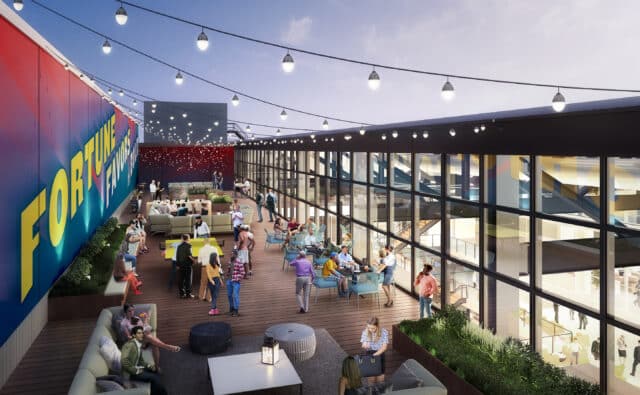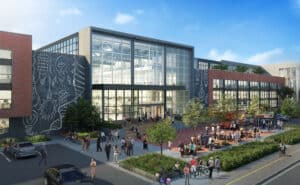Ogden Hunnewell is pretty sure nothing was left behind. No leftover reporters’ notebooks. No ancient typewriters. No black-and-white photos tucked in a box. No barrels of ink stashed in the basement.
“We never found anything in the building,” said Hunnewell. “Nothing romantic. They took all of the Pulitzers.”
But Hunnewell, executive vice president and partner at Burlington-based Nordblom Co., did confirm one thing about the old Boston Globe headquarters building on Morrissey Boulevard, after his firm spent millions gutting and demolishing some portions the 61-year-old complex: “It’s built like a fortress. It’s got good bones.”
Nordblom is increasingly confident that its massive $200 million conversion of the former newspaper plant into a new office, labs and light-industrial complex, now nicknamed “The Beat,” is going to be a big hit when it’s completed next year.
“We’re seeing a lot of interest,” said Hunnewell of potential tenants inquiring about possibly leasing space at the nearly 700,000-square-foot facility. “We’re encouraged by the traffic.”
Tight Market, Good Location
Commercial real estate insiders say they’re not surprised to hear interest is strong in Nordblom’s latest commercial venture.
Though the Beat is located well south of Boston’s booming downtown along Interstate 93 in Dorchester, industry officials say there are two huge pluses going in Nordblom’s favor: The scarcity of available commercial space in the Financial District, Back Bay, Seaport and Cambridge’s Kendall Square, and its location just off the Red Line.
“If you’re a tenant of big size looking for space in Boston, you have few options today,” said David Martel, executive managing director at Newmark Knight Frank. “I think they’re going to do well. [The Beat] speaks to a lot of what people want and need today.”
William Catlin, senior partner and managing director at Boston Realty Advisors, agrees The Beat is “positioned very well” after the conversion project is completed next spring.
One of his clients, a medical device company, recently toured the former Globe facility, originally built in 1958, and came away impressed.
“They said it could be an interesting play for them,” he said.

Nordblom is hoping to wow potential tenants with a completely rehabbed facility, which will include a multi-story atrium, and amenities such as a possible 100-plus-seat restaurant and brewery and more than 800 parking spaces. Image courtesy of Add Inc./Stantec
Another plus for Nordblom: barring a dramatic downturn in the economy and real estate market between now and next spring, class A office space in Boston is renting today anywhere from about $65 to $110 per square foot.
Because the Beat is a conversion project – which usually costs significantly less than ground-up new construction – Nordblom could theoretically rent the space in the mid $50s range in order to make a profit – and make it an attractive option for firms looking for space in Boston, industry executives say.
Development Plan with Built-in Flexibility
Who and what exactly goes into the finished project is still up in the air.
According to preliminary plans, the Beat will include 360,000 square feet of office space, 300,000 square feet of flex/light-industrial space and 10,000 square feet of retail space. The property is being marketed as “new economy” space, available for possible use by finance, health-related and tech companies in the offices, as well as robotics, 3-D printing and other light industrial users in other spaces.
Indeed, the brand name “Beat,” while obviously a play on journalistic lingo, technically stands for “Boston Exchange for Accelerated Technology.”
Nordblom’s Hunnewell is open to “changing the mix” of space in the building, depending on tenant demand.
Nordblom is hoping to wow potential tenants with a completely rehabbed facility, which will include a multi-story atrium, and amenities such as a possible 100-plus–seat restaurant and brewery and more than 800 parking spaces.
Though the 3-story building, located on 16.6 acres, is associated with its journalistic past, it was also formerly a printing plant, with a tremendous amount of inks and other chemicals regularly stored and used at the site while the Globe was there. But Hunnewell said that, besides asbestos used in the building’s original construction, the site was remarkably clean when Nordblom purchased it in 2017.
“The Globe was a pretty good citizen,” he said. “They started with a clean site [in 1958] and basically kept it that way. We were encouraged with what we found.”
Now it’s time to fill the complex, a process that could take two years, though Nordblom is guardedly optimistic in can be filled sooner. No leases have been signed yet. But Todd Fremonth-Smith, a senior vice president at Nordblom, said “we’re getting good traction.”
The site’s location along the Red Line is a big selling point for potential tenants, he said, and the fact they can say they’re in Boston.
“There’re not a lot of products coming online along the Red Line,” he said. “The timing of this project is great.”







